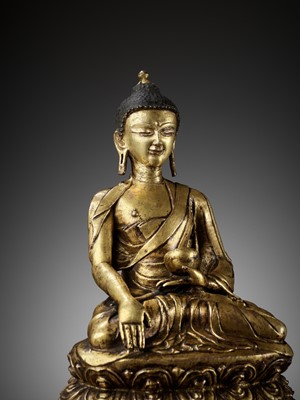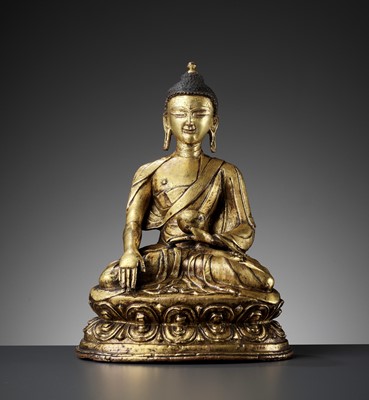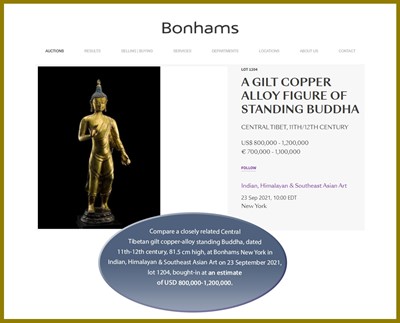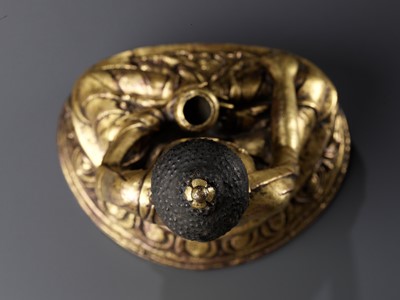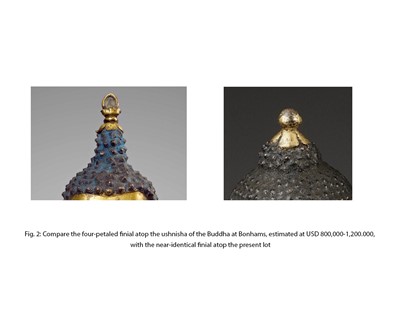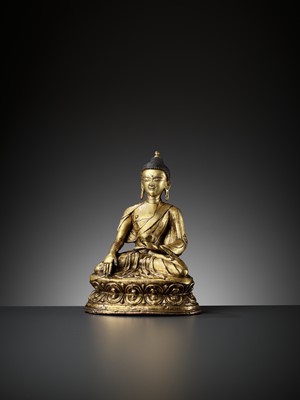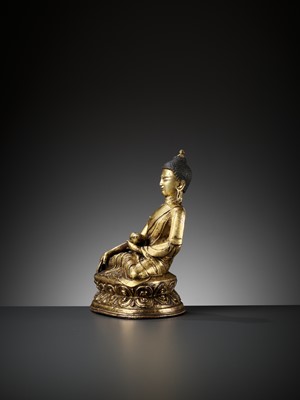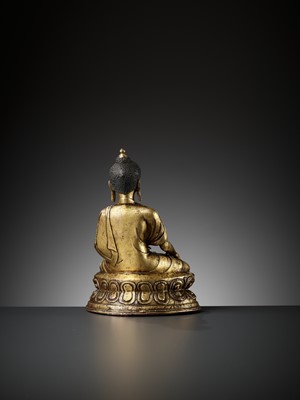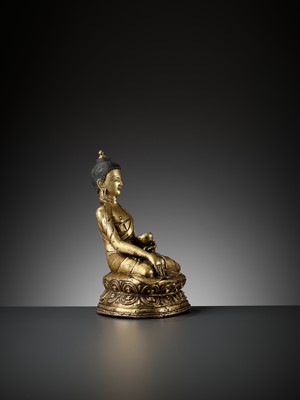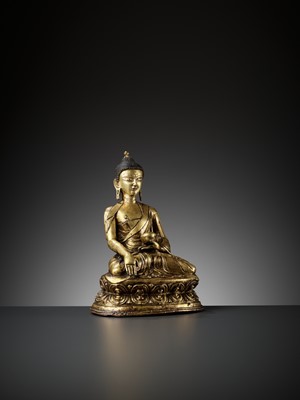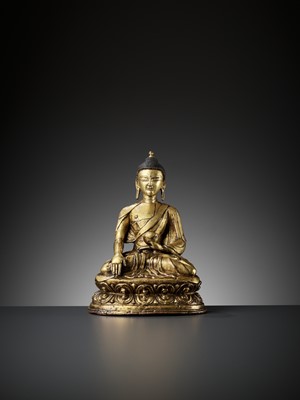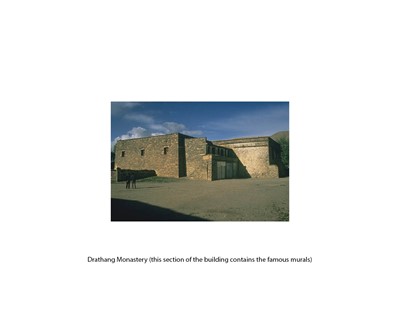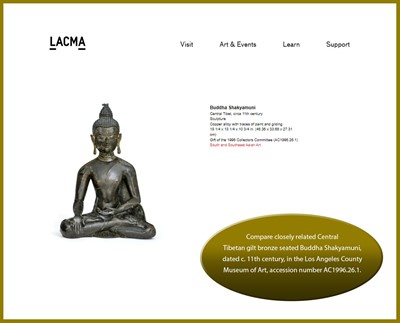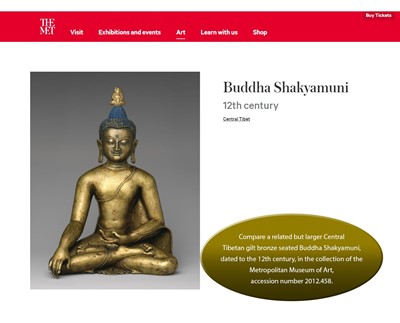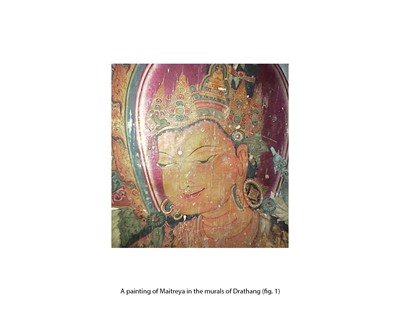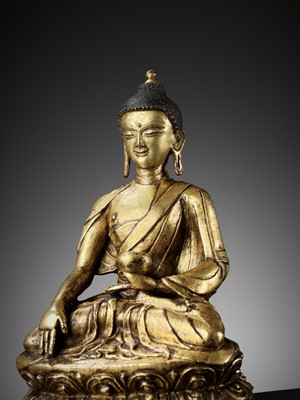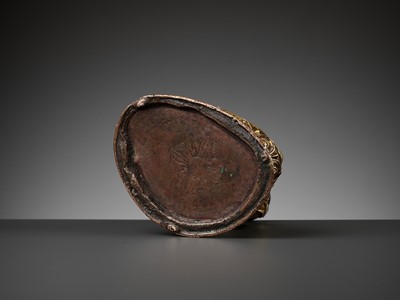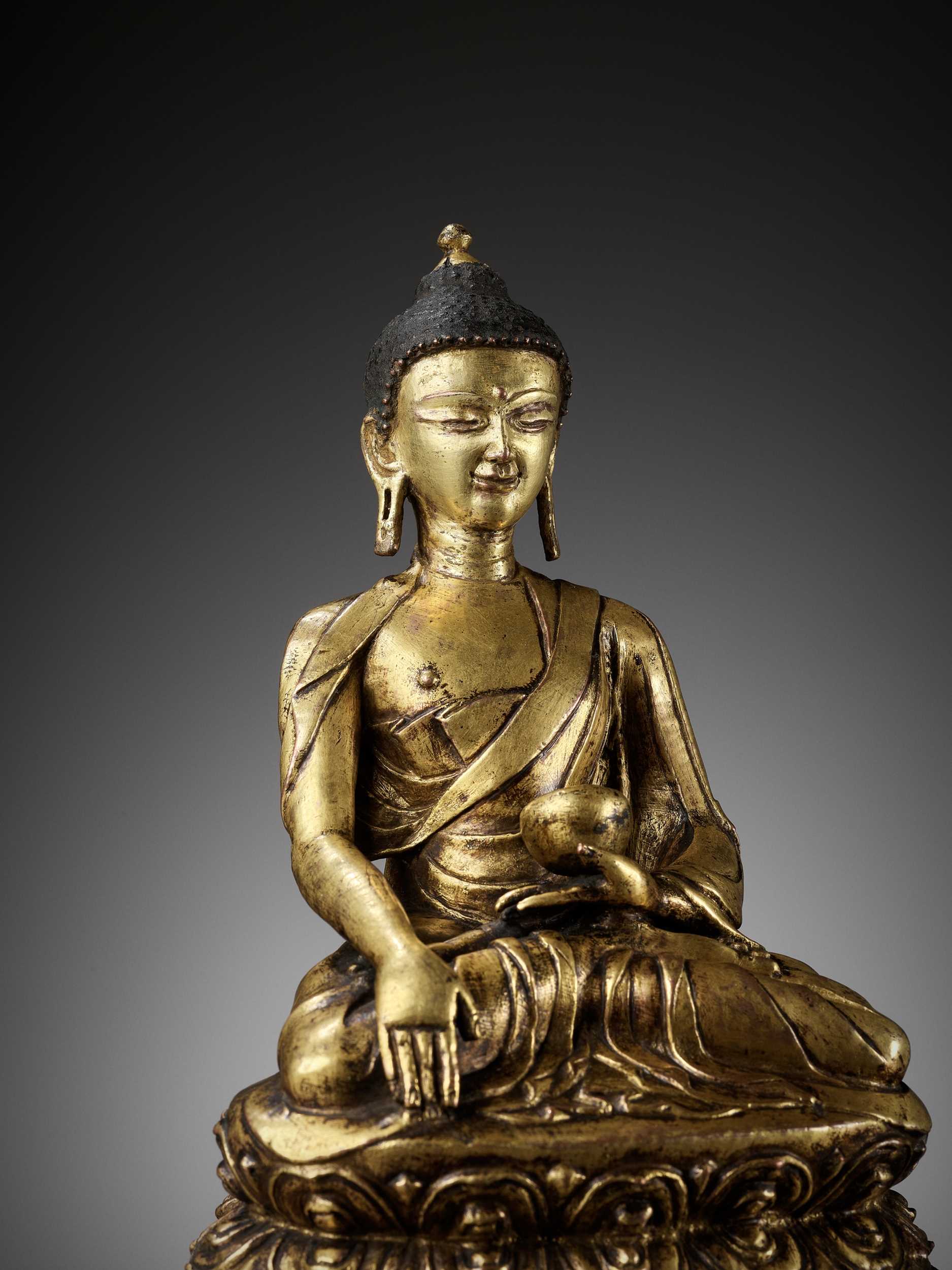11th Mar, 2022 10:00
DAY 2 - TWO-DAY AUCTION - Fine Chinese Art / 中國藝術集珍 / Buddhism & Hinduism
394
A GILT COPPER ALLOY FIGURE OF BUDDHA, 11TH-12TH CENTURY
十一至十二世紀銅鎏金坐佛像
Sold for €10,112
including Buyer's Premium
Central Tibet. Superbly cast, seated in dhyanasana on a double lotus base, the right hand lowered in bhumisparsa mudra and the left above his lap holding a separately cast alms bowl. His richly pleated monastic robe is draped over both shoulders and cascades in voluminous folds. The exquisite face with heavy-lidded eyes below gently arched, remarkably wide eyebrows. Centered by an urna above full lips forming a benevolent smile, flanked by long, pierced, rectangular earlobes. The hair arranged in tight curls surmounted by a domed ushnisha with a distinctive four-petaled bud finial (see fig. 2).
Provenance: From a noted Hungarian private collection, by repute acquired in Central Asia between 1950 and 1960, thence by descent in the same family.
Condition: Excellent condition, fully commensurate with age. The base possibly resealed a long time ago. Some wear and casting irregularities. Small nicks, minor dents, and light surface scratches. Fine, naturally grown patina overall. Remnants of ancient pigments and old varnish.
Weight: 1,668 g
Dimensions: Height 20.6 cm
This fine and distinctive sculpture of Shakyamuni Buddha, created during a period that marks both the revival of Buddhism in Tibet and a formative phase in Tibetan Buddhist art, has arguably more in common with Buddha images of North India and Central Asia from the previous 500 years than with those produced during the subsequent millennia of Tibetan sculpture. The face’s blend of Indian and Tibetan features results in a countenance of confident nobility. Its distinct modeling makes this gilt bronze a rather singular depiction of Shakyamuni Buddha from Tibet, while at the same time wonderfully encapsulating the archaism of Tibetan art at a pivotal moment of its history.
Produced between 1081-93, the murals of Drathang correlate to the present lot. Borrowings from the Pala-Sena style are apparent throughout. For example, while the present Shakyamuni’s handsome face has a squarer, more Tibetan physiognomy than Buddhist bronzes made in India around the 11th century, his mouth, eyes, and brow mimic features of the Pala style – a combination present throughout the host of bodhisattvas painted at Drathang. Compare the treatment of the plump lower lip and recessed rounded corner of the smile of a painted Maitreya (see fig. 1). The present Shakyamuni also adopts the undulating upper lid of Maitreya’s eye, as well as his sinuous brow with upturned ends.
The idiosyncratic sculpture and painting created in Central Tibet during the 11th century embrace contemporary doctrinal and stylistic innovation while also celebrating the Buddhism that was practiced in Tibet when the religion was first introduced. As such, this Buddha provides a rare glimpse into the formative period of the Second Diffusion, when Tibet revived its patronage of Buddhism.
Literature comparison: Compare a related but larger Central Tibetan gilt bronze seated Buddha Shakyamuni, dated to the 12th century, in the collection of the Metropolitan Museum of Art, accession number 2012.458; and a closely related Central Tibetan gilt bronze seated Buddha Shakyamuni, dated c. 11th century, in the Los Angeles County Museum of Art, accession number AC1996.26.1.
Auction result comparison: Compare a closely related Central Tibetan gilt copper-alloy standing Buddha, dated 11th-12th century, 81.5 cm high, at Bonhams New York in Indian, Himalayan & Southeast Asian Art on 23 September 2021, lot 1204, bought-in at an estimate of USD 800,000-1,200,000. Note the similar four-petaled finial atop the ushnisha (see fig. 2) as well as the similarly cast face with undulating upper lid, full lips, and rectangular lobes.
十一至十二世紀銅鎏金坐佛像
西藏。以精銅鑄造,鎏金璀璨。結全跏趺坐,右手自然下垂,施降魔觸地印,左手托鉢於腹前,坐於仰覆蓮座上。肉髻高隆呈塔形,螺髮排列規整,寶珠頂嚴。寬額豐頤,雙耳垂肩,彎眉細長與鼻脛相連,點丹白毫,雙目微合下視,嘴角微露笑意,神態怡然,法相莊嚴。頸施三道弦紋,胸膛寬闊,腰部收束,著袒右肩袈裟。薄衣貼體,衣紋轉折流暢自然,富有層次感。蓮瓣寬大飽滿。座下固封裝藏保存完好,底蓋中央鏨刻精美十字金剛杵紋。
來源:匈牙利知名私人收藏,據説於上世紀五十至六十年代購於中亞,自此保存在同一家族至今。
品相:狀況極佳,與年齡完全相稱。 底座可能很久以前曾重新密封過。 一些磨損和鑄造不規則。 小刻痕、輕微的凹痕和表面劃痕。 整體上包漿精細自然。古代顏料和舊清漆的殘餘物。
重量:1,668 克
尺寸:高 20.6 厘米
這尊精美而獨特的釋迦牟尼佛像應該製於於藏傳佛教復興與其藝術形成階段時期,與隨後數千年的藏傳造像相比,他可以說與過去500年來北印度和中亞的佛像有更多共同之處。他的面部融合了印度和西藏的特徵,顯得自信高貴。 其造型獨特更加體現了西藏藝術的古樸。
扎塘寺的壁畫創作於 1081 至 1093 年間,與現在的拍品密切相關。他顯而易見自始至終都借用了帕拉塞納風格。 例如,雖然現在釋迦牟尼的面容比 11 世紀左右印度製造的佛教造像更為方正,但他的嘴、眼睛和眉毛卻模仿了帕拉風格——這種組合存在於扎塘寺壁畫。 比較彩繪彌勒佛豐滿下唇和笑容凹陷圓角的處理(見圖1),現在的釋迦牟尼也採用了彌勒的上眼瞼起伏,眉梢上翹。
11世紀,來自西藏中部的獨特造像和繪畫包含了當時的教義和風格的創新,同時也頌揚了西藏當時所奉行的佛教。 因此,這尊佛陀提供了一個難得的機會,讓我們得以目睹佛教第二次在西藏得到發揚時的光輝。
文獻比較:比較一件十二世紀更大型的來自西藏的銅鎏金釋迦牟尼坐像,收藏於大都會藝術博物館,編號 2012.458; 一件十一世紀西藏銅鎏金釋迦牟尼坐像,見洛杉磯美術館,編號 AC1996.26.1。
拍賣結果比較:比較一件十一至十二世紀西藏銅鎏金立佛,高81.5厘米,見紐約邦翰思Indian, Himalayan & Southeast Asian Art 2021年9月23日 lot 1204, 估價USD 800,000-1,200,000,注意其四瓣寶珠頂嚴 (見圖 2) 與面容表現以及起伏的上眼瞼、豐滿的嘴唇和長方形的耳垂。
Central Tibet. Superbly cast, seated in dhyanasana on a double lotus base, the right hand lowered in bhumisparsa mudra and the left above his lap holding a separately cast alms bowl. His richly pleated monastic robe is draped over both shoulders and cascades in voluminous folds. The exquisite face with heavy-lidded eyes below gently arched, remarkably wide eyebrows. Centered by an urna above full lips forming a benevolent smile, flanked by long, pierced, rectangular earlobes. The hair arranged in tight curls surmounted by a domed ushnisha with a distinctive four-petaled bud finial (see fig. 2).
Provenance: From a noted Hungarian private collection, by repute acquired in Central Asia between 1950 and 1960, thence by descent in the same family.
Condition: Excellent condition, fully commensurate with age. The base possibly resealed a long time ago. Some wear and casting irregularities. Small nicks, minor dents, and light surface scratches. Fine, naturally grown patina overall. Remnants of ancient pigments and old varnish.
Weight: 1,668 g
Dimensions: Height 20.6 cm
This fine and distinctive sculpture of Shakyamuni Buddha, created during a period that marks both the revival of Buddhism in Tibet and a formative phase in Tibetan Buddhist art, has arguably more in common with Buddha images of North India and Central Asia from the previous 500 years than with those produced during the subsequent millennia of Tibetan sculpture. The face’s blend of Indian and Tibetan features results in a countenance of confident nobility. Its distinct modeling makes this gilt bronze a rather singular depiction of Shakyamuni Buddha from Tibet, while at the same time wonderfully encapsulating the archaism of Tibetan art at a pivotal moment of its history.
Produced between 1081-93, the murals of Drathang correlate to the present lot. Borrowings from the Pala-Sena style are apparent throughout. For example, while the present Shakyamuni’s handsome face has a squarer, more Tibetan physiognomy than Buddhist bronzes made in India around the 11th century, his mouth, eyes, and brow mimic features of the Pala style – a combination present throughout the host of bodhisattvas painted at Drathang. Compare the treatment of the plump lower lip and recessed rounded corner of the smile of a painted Maitreya (see fig. 1). The present Shakyamuni also adopts the undulating upper lid of Maitreya’s eye, as well as his sinuous brow with upturned ends.
The idiosyncratic sculpture and painting created in Central Tibet during the 11th century embrace contemporary doctrinal and stylistic innovation while also celebrating the Buddhism that was practiced in Tibet when the religion was first introduced. As such, this Buddha provides a rare glimpse into the formative period of the Second Diffusion, when Tibet revived its patronage of Buddhism.
Literature comparison: Compare a related but larger Central Tibetan gilt bronze seated Buddha Shakyamuni, dated to the 12th century, in the collection of the Metropolitan Museum of Art, accession number 2012.458; and a closely related Central Tibetan gilt bronze seated Buddha Shakyamuni, dated c. 11th century, in the Los Angeles County Museum of Art, accession number AC1996.26.1.
Auction result comparison: Compare a closely related Central Tibetan gilt copper-alloy standing Buddha, dated 11th-12th century, 81.5 cm high, at Bonhams New York in Indian, Himalayan & Southeast Asian Art on 23 September 2021, lot 1204, bought-in at an estimate of USD 800,000-1,200,000. Note the similar four-petaled finial atop the ushnisha (see fig. 2) as well as the similarly cast face with undulating upper lid, full lips, and rectangular lobes.
十一至十二世紀銅鎏金坐佛像
西藏。以精銅鑄造,鎏金璀璨。結全跏趺坐,右手自然下垂,施降魔觸地印,左手托鉢於腹前,坐於仰覆蓮座上。肉髻高隆呈塔形,螺髮排列規整,寶珠頂嚴。寬額豐頤,雙耳垂肩,彎眉細長與鼻脛相連,點丹白毫,雙目微合下視,嘴角微露笑意,神態怡然,法相莊嚴。頸施三道弦紋,胸膛寬闊,腰部收束,著袒右肩袈裟。薄衣貼體,衣紋轉折流暢自然,富有層次感。蓮瓣寬大飽滿。座下固封裝藏保存完好,底蓋中央鏨刻精美十字金剛杵紋。
來源:匈牙利知名私人收藏,據説於上世紀五十至六十年代購於中亞,自此保存在同一家族至今。
品相:狀況極佳,與年齡完全相稱。 底座可能很久以前曾重新密封過。 一些磨損和鑄造不規則。 小刻痕、輕微的凹痕和表面劃痕。 整體上包漿精細自然。古代顏料和舊清漆的殘餘物。
重量:1,668 克
尺寸:高 20.6 厘米
這尊精美而獨特的釋迦牟尼佛像應該製於於藏傳佛教復興與其藝術形成階段時期,與隨後數千年的藏傳造像相比,他可以說與過去500年來北印度和中亞的佛像有更多共同之處。他的面部融合了印度和西藏的特徵,顯得自信高貴。 其造型獨特更加體現了西藏藝術的古樸。
扎塘寺的壁畫創作於 1081 至 1093 年間,與現在的拍品密切相關。他顯而易見自始至終都借用了帕拉塞納風格。 例如,雖然現在釋迦牟尼的面容比 11 世紀左右印度製造的佛教造像更為方正,但他的嘴、眼睛和眉毛卻模仿了帕拉風格——這種組合存在於扎塘寺壁畫。 比較彩繪彌勒佛豐滿下唇和笑容凹陷圓角的處理(見圖1),現在的釋迦牟尼也採用了彌勒的上眼瞼起伏,眉梢上翹。
11世紀,來自西藏中部的獨特造像和繪畫包含了當時的教義和風格的創新,同時也頌揚了西藏當時所奉行的佛教。 因此,這尊佛陀提供了一個難得的機會,讓我們得以目睹佛教第二次在西藏得到發揚時的光輝。
文獻比較:比較一件十二世紀更大型的來自西藏的銅鎏金釋迦牟尼坐像,收藏於大都會藝術博物館,編號 2012.458; 一件十一世紀西藏銅鎏金釋迦牟尼坐像,見洛杉磯美術館,編號 AC1996.26.1。
拍賣結果比較:比較一件十一至十二世紀西藏銅鎏金立佛,高81.5厘米,見紐約邦翰思Indian, Himalayan & Southeast Asian Art 2021年9月23日 lot 1204, 估價USD 800,000-1,200,000,注意其四瓣寶珠頂嚴 (見圖 2) 與面容表現以及起伏的上眼瞼、豐滿的嘴唇和長方形的耳垂。
Zacke Live Online Bidding
Our online bidding platform makes it easier than ever to bid in our auctions! When you bid through our website, you can take advantage of our premium buyer's terms without incurring any additional online bidding surcharges.
To bid live online, you'll need to create an online account. Once your account is created and your identity is verified, you can register to bid in an auction up to 12 hours before the auction begins.
Intended Spend and Bid Limits
When you register to bid in an online auction, you will need to share your intended maximum spending budget for the auction. We will then review your intended spend and set a bid limit for you. Once you have pre-registered for a live online auction, you can see your intended spend and bid limit by going to 'Account Settings' and clicking on 'Live Bidding Registrations'.
Your bid limit will be the maximum amount you can bid during the auction. Your bid limit is for the hammer price and is not affected by the buyer’s premium and VAT. For example, if you have a bid limit of €1,000 and place two winning bids for €300 and €200, then you will only be able to bid €500 for the rest of the auction. If you try to place a bid that is higher than €500, you will not be able to do so.
Online Absentee and Telephone Bids
You can now leave absentee and telephone bids on our website!
Absentee Bidding
Once you've created an account and your identity is verified, you can leave your absentee bid directly on the lot page. We will contact you when your bids have been confirmed.
Telephone Bidding
Once you've created an account and your identity is verified, you can leave telephone bids online. We will contact you when your bids have been confirmed.
Classic Absentee and Telephone Bidding Form
You can still submit absentee and telephone bids by email or fax if you prefer. Simply fill out the Absentee Bidding/Telephone bidding form and return it to us by email at office@zacke.at or by fax at +43 (1) 532 04 52 20. You can download the PDF from our Upcoming Auctions page.
How-To Guides
How to Create Your Personal Zacke Account
How to Register to Bid on Zacke Live
How to Leave Absentee Bids Online
How to Leave Telephone Bids Online
中文版本的操作指南
创建新账号
注册Zacke Live在线直播竞拍(免平台费)
缺席投标和电话投标
Third-Party Bidding
We partner with best-in-class third-party partners to make it easy for you to bid online in the channel of your choice. Please note that if you bid with one of our third-party online partners, then there will be a live bidding surcharge on top of your final purchase price. You can find all of our fees here. Here's a full list of our third-party partners:
- 51 Bid Live
- EpaiLive
- ArtFoxLive
- Invaluable
- LiveAuctioneers
- the-saleroom
- lot-tissimo
- Drouot
Please note that we place different auctions on different platforms. For example, in general, we only place Chinese art auctions on 51 Bid Live.
Bidding in Person
You must register to bid in person and will be assigned a paddle at the auction. Please contact us at office@zacke.at or +43 (1) 532 04 52 for the latest local health and safety guidelines.
